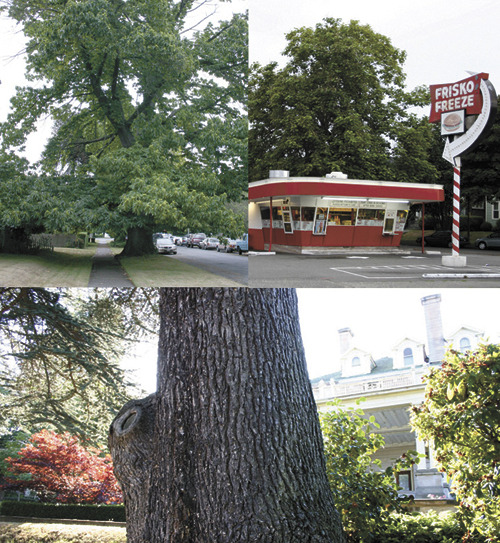The City of Tacoma is moving closer to creating a heritage register to protect and honor some of its oldest urban trees.
A stakeholder group formed by EverGreen Tacoma, the city’s urban forestry program, has discussed the plan for several months. During two public meetings earlier this month, the group reached several key conclusions for how Tacomans could add old trees to a heritage register.
According to the current proposal, an Urban Forestry Board would be created to accept heritage tree nominations. The nominations would include a map, photograph, age and species of tree, International Society of Arboriculture rating, reason for the nomination, and an inspection report from a certified arborist. If a nominated tree affects an adjacent property owner, that property owner must agree to the nomination. Neighbors would be notified of the nomination by postcard and a sign posted near the tree. Heritage trees would require a covenant to be recorded with the Pierce County Auditor’s office, a city registry of all heritage trees would be available to the public, and heritage tree plaques designed by the City but paid for by the applicant would be available but not required.
The nine-member Urban Forestry Board would consist of representatives with professional and technical expertise; members of the business community; citizens at-large; members of the city’s neighborhood councils, community council or cross-district association; members of a large public agency that owns a large amount of public land; and non?profit advocacy groups for urban forestry or open space.
The plan is part of an overall revamp of the city’s urban forestry code that still needs to be approved by Tacoma City Council. During an interview Wednesday, Tacoma’s Urban Forester Ramie Pierce said the department’s goal is for the code revision and heritage tree register to be approved before the end of this year. But there is still more public discussion ahead. “The public and City Council could have different ideas,” said Pierce. “Part of building the program is getting the code adopted, setting up a board, [creating] branding, educational pieces, [and] a Web site. It will still be a little while. There’s still that process to go through. Then it’s a matter of resources for implementation. It wouldn’t all happen at once. There’s a lot to get done.”
The Tacoma Daily Index first reported on heritage trees in 2008. At the time, Pierce told the Index there was a high level of interest in creating a heritage register. “[Heritage trees] may seem unusual to somebody who is not in the industry,” said Pierce. “But it’s becoming more and more commonplace. People are appreciating trees a lot more, and they’re more aware of the significance of larger, secure trees. It seems like [Tacoma] is old enough now. Why don’t we have this? Other people have requested a similar program, so I know there is interest.”
Indeed, other Pacific Northwest cities have heritage tree programs. The City of Vancouver created its program in 1998; its register includes an apple tree dating back to 1826. The City of Seattle created a heritage tree program in 1996.
In Tacoma, three highly visible trees in and around the North Slope Historic District could be prime candidates for the register, according to North Slope Historic District resident and preservation activist Marshall McClintock. In 2008, McClintock told the Index he has spent hours in the Northwest Room at the Tacoma Public Library searching through archives that document the city’s street beautification projects. He’s also consulted “Champion Trees of Washington State” by Robert Van Pelt to learn more about heritage trees. According to McClintock, a Cedar of Lebanon tree located near the historic Rust Mansion on North I Street was part of the mansion’s original landscaping, and could date back as far as 1905. A large Spanish Chestnut tree located on a parking strip near North Sheridan Avenue and North Fifth Street was planted between 1890 and 1910 as part of a street beautification project, said McClintock. And a Catalpa tree located near Frisko Freeze also dates back to between 1890 and 1910, he added.
“These trees are ones that are recognized and people sort of consider them to be iconic,” McClintock told the Index. “People know, ‘Oh, the big Chestnut tree.’ They are aware of it. In fact, I think they would probably want to register more of them. I get a number of calls from people who are upset when large trees are taken down.”


Todd Matthews is editor of the Tacoma Daily Index and recipient of an award for Outstanding Achievement in Media from the Washington State Department of Archaeology and Historic Preservation for his work covering historic preservation in Tacoma and Pierce County. He has earned four awards from the Society of Professional Journalists, including third-place honors for his feature article about the University of Washington’s Innocence Project; first-place honors for his feature article about Seattle’s bike messengers; third-place honors for his feature interview with Prison Legal News founder Paul Wright; and second-place honors for his feature article about whistle-blowers in Washington State. His work has also appeared in All About Jazz, City Arts Tacoma, Earshot Jazz, Homeland Security Today, Jazz Steps, Journal of the San Juans, Lynnwood-Mountlake Terrace Enterprise, Prison Legal News, Rain Taxi, Real Change, Seattle Business Monthly, Seattle magazine, Tablet, Washington CEO, Washington Law & Politics, and Washington Free Press. He is a graduate of the University of Washington and holds a bachelor’s degree in communications. His journalism is collected online at wahmee.com.








